This piperade recipe is a Basque sauce made with just a few ingredients including bell peppers and piment d'Espelette, serve it with eggs, grilled or roasted meats, in omelettes, and more! It has a deliciously sweet and spicy flavor combination and it's so easy to make.
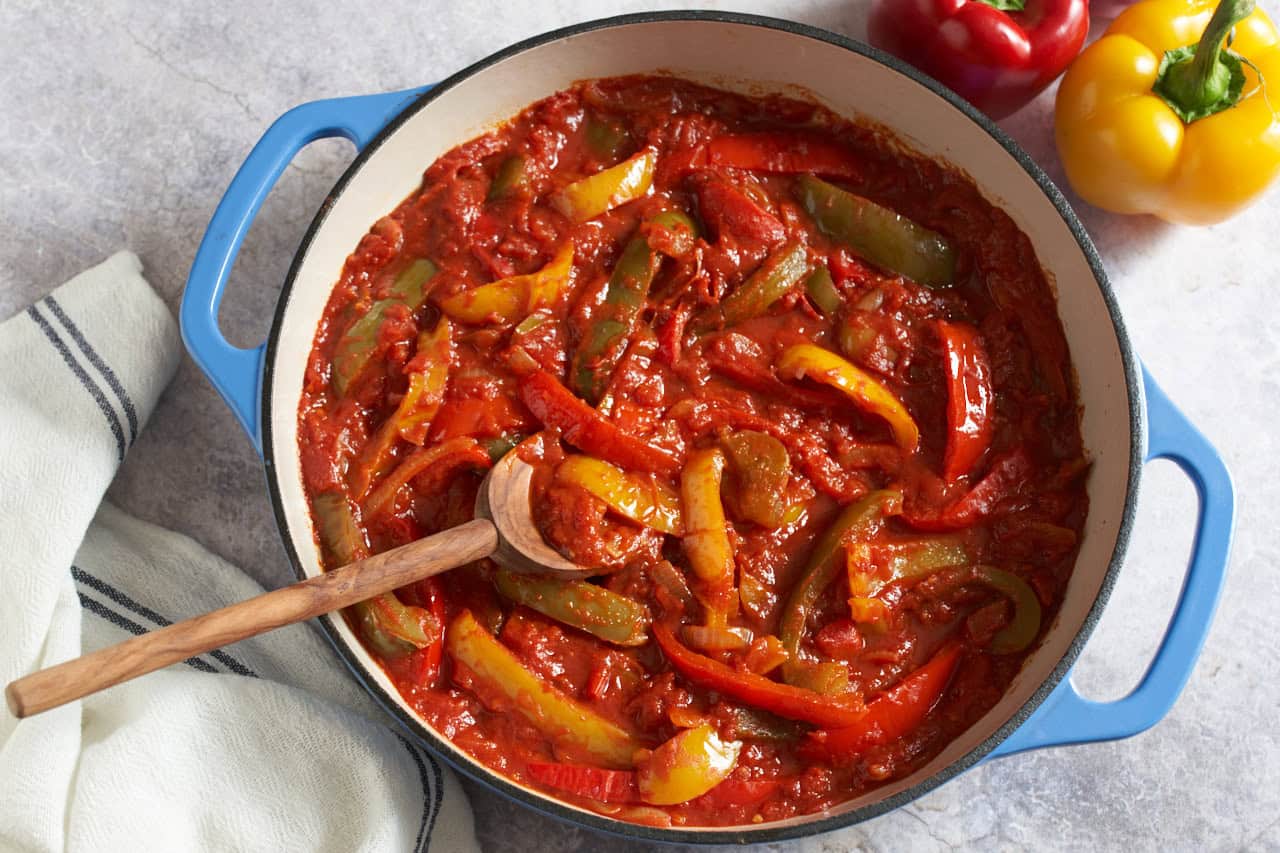
If you're familiar with the sauce in Shakshuka, you'll find that piperade is a similar dish, however the unique ingredient of piment d'Espelette sets the flavor apart.
It's a versatile pepper sauce that can be served in so many ways, and a great way to use fresh bell peppers when they're in season! It's also easy to make ahead and freeze for later.
If you like simple sauces with big flavor, you'll love this San Marzano Tomato Sauce recipe!
Jump to:
What is piperade?
Piperade, or Piperade Basquaise, is a traditional sauce recipe from the Basque region, which straddles the northern border between France and Spain. It is typically made with tomatoes, bell peppers, onions, and sometimes ham, and seasoned with piment d'Espelette, a spice from the region.
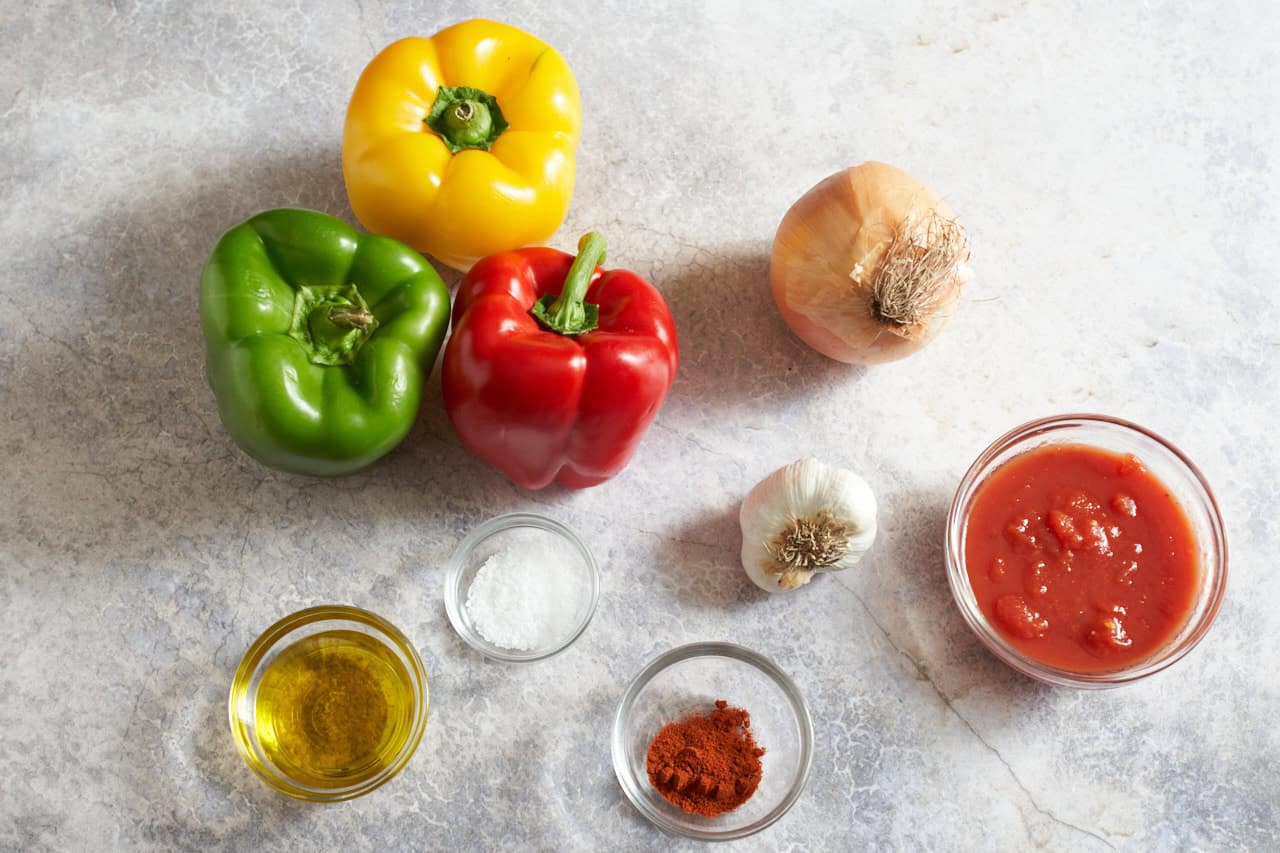
Piperade ingredients
- Red, yellow and green bell peppers: Traditionally, Basque piperade is made with green, yellow, and red bell peppers. You can use all of the colors or only the sweet peppers like I do in my Greek Stuffed Peppers recipe.
- Yellow onion: We'll slice the onions thinly and cook them down until caramelized and delicious. I like sweet yellow onions here because they complement the sweetness of the bell peppers.
- Garlic: We'll use just 2 cloves of garlic, not too much. You know I sometimes like big slices of garlic in sauces, but in this case we will grate it, so the flavor permeates the entire sauce.
- Piment d'Espelette: A unique spice of the Basque region, piment d'Esplette has a lightly smoky flavor with a hint of heat and it's a key ingredient for piperade.
- Canned San Marzano tomatoes: Many piperade recipes call for fresh tomatoes, but for consistency of flavor and texture and ease of preparation, I love canned tomatoes here. San Marzano are my favorite, and if you've been following me at all you know I use them in everything from soups to lasagna.
- Extra virgin olive oil, kosher salt: We just need a small amount of oil and wait until the end to salt! See tips below.
- Optional add-ins: Sometimes piperade is made with jambon de Bayonne in the recipe, a Basque cured ham similar to prosciutto. If using, cook it for a minute or so in the pan before you add the peppers and onions.
How to make piperade

Step 1: Slice the vegetables
Use a good chef's knife and slice the vegetables into strips. Grate the garlic with a microplane grater, or mince it finely.

Step 2: Cook the bell peppers and onions
Add the olive oil to a wide, deep skillet over medium-high heat, once it's shimmering add the thinly sliced peppers and onions. Cook for 8-10 minutes until the onions are soft and translucent and just beginning to take on some color, the peppers will probably be lightly blistered.
Pro tip
If you feel like the onions are cooking quickly and getting dark too fast, add some water to the pan and turn down to medium heat.
Add the grated garlic and piment d'Espelette and stir to coat the vegetables. Keep stirring for 1-2 minutes until the garlic is fragrant and the spice has bloomed. Add a pinch of salt.
Want to save this recipe?
You'll be added to my email list!
Disclosure: This pan was gifted to me by Lodge Cast Iron, all opinions are my own.
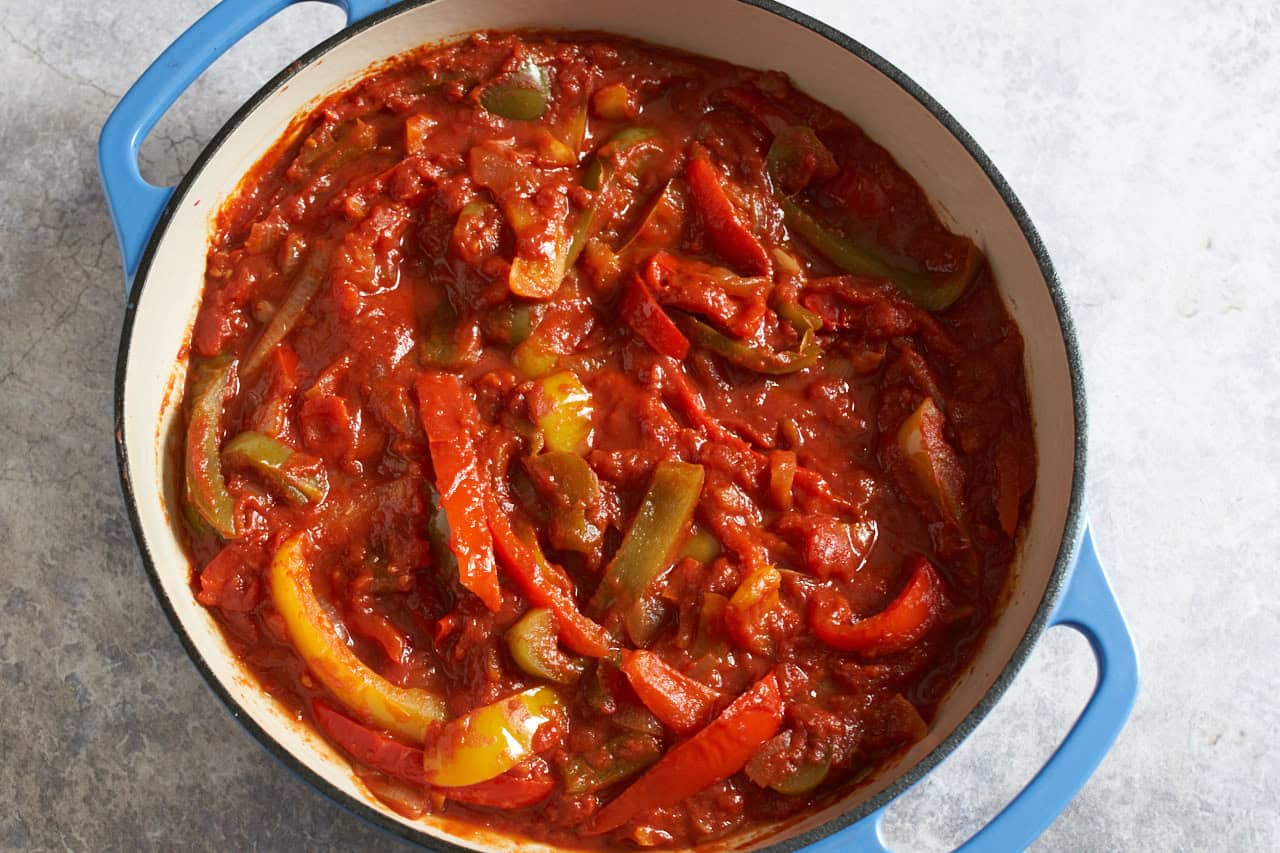
Step 3: Add the canned tomatoes and simmer
Pour the can of tomatoes into a bowl and crush them by hand. Fill the can about ⅓ full of water and swish around to get the remaining sauce out of it. Add the tomatoes and the water from the can to the skillet and bring to a low simmer.
Cook for about 10-15 minutes until the piperade sauce has reduced slightly. Season with kosher salt and serve.
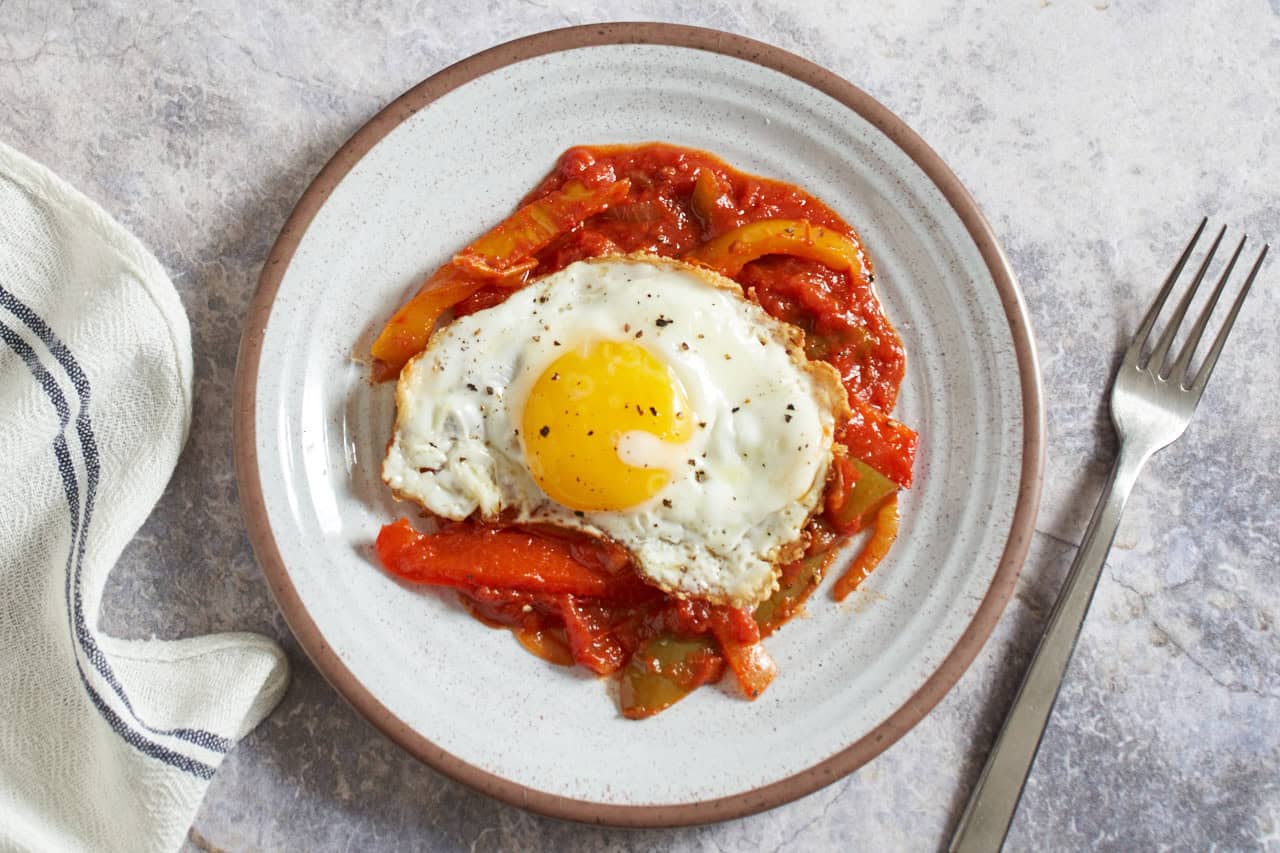
Expert tips
- Wait to season the sauce with salt: The piperade has to cook down a bit once you add the tomatoes, and if you season it right away, it might turn out too salty. Wait until it's reduced, then stir in the salt, taste, and adjust if necessary.
- You can cook longer for softer vegetables: I like the bell peppers to retain some of their texture, but if you prefer softer peppers, simply turn the heat down to low, cover the skillet with a lid and cook for an additional 5-10 minutes until they are the softness you're looking for.
- Add a pinch of sugar: If you find that the sauce is too spicy, or maybe your canned tomatoes were meh, add a pinch of sugar to sweeten things up.
How to use and serve piperade
- Piperade with eggs: Once the sauce finishes reducing, you can crack some eggs right into it and either put a lid on the skillet to cook over low heat, or pop it into a 350 degree oven and bake the eggs until they are cooked to your liking.
- Omelette piperade: Fill your omelettes with piperade sauce and serve for a light dinner with a simple salad. This is a classic French recipe!
- Sauce for meats and roasted vegetables: Serve piperade alongside grilled meats or vegetables, or with roast chicken.
Substitutes for piment d'Espelette
Although piment d'Espelette has its own unique flavor, it can be harder to find and on the expensive side, so if you'd prefer to make a substitution try these ideas.
- Use smoked paprika: Smoked paprika will give you the light sweetness and earthiness of piment d'Espelette, with a little less heat.
- Try hot paprika (but be careful!): If you like your piperade spicy, swap in hot paprika 1:1, but this could be pretty hot! Taste your paprika (different brands have different heat levels) and adjust the amount downward if it's really spicy.
- Mix it up with smoked and hot paprika, or add other spices for heat: Use mostly smoked paprika with a pinch of hot paprika, cayenne pepper, or crushed red pepper flakes.
Make ahead, storage, and freezing
- To make ahead: You can make piperade up to 3 days ahead, store in an airtight container in the refrigerator.
- To store: Keep in an airtight container in the refrigerator for up to 3 days.
- To freeze: Chill in the refrigerator overnight in a freezer safe container (I like these reusable silicone pouches for sauces like this), then transfer to the freezer for up to 3 months.
Piperade is a versatile Basque sauce recipe with simple ingredients
- Piment d'Espelette adds a unique flavor, but you can find substitutions.
- Use it in so many ways, anywhere you want a sweet and spicy sauce.
- It freezes well, so make a big batch!
- Vegetarian, vegan, gluten-free and dairy-free!
More Spanish and French recipes
The Basque region is in both France and Spain, so explore more recipes from each country!
If you enjoy this recipe, please leave me a 5-star rating ⭐️⭐️⭐️⭐️⭐️ in the recipe card! It really helps others find my content and helps my business grow! Sign up for my newsletter for recipes delivered to your inbox and follow me on Instagram and Pinterest! Thank you!
Recipe

Piperade Recipe
Equipment
- microplane grater optional
Ingredients
- 3 bell peppers mix of red, yellow and green, or just one color
- 1 yellow onion
- 2 cloves garlic
- 2 tablespoon olive oil
- 1 teaspoon piment d'Espelette or smoked paprika, see note
- 28 ounces canned San Marzano tomatoes
- ½ teaspoon kosher salt
Instructions
- Slice the peppers and onions into strips. Grate the garlic with a microplane grater, or mince it finely.
- Add the olive oil to a wide, deep skillet over medium-high heat, once it's shimmering add the peppers and onions. Cook for 8-10 minutes, stirring occasionally, until the onions are soft and translucent and just beginning to take on some color, the peppers will probably be lightly blistered.
- Add the grated garlic and piment d'Espelette and stir to coat the vegetables. Keep stirring for 1-2 minutes until the garlic is fragrant and the spice has bloomed. Add a pinch of salt.
- Pour the can of tomatoes into a bowl and crush them by hand. Fill the can about ⅓ full of water and swish around to get the remaining sauce out of it. Add the tomatoes and the water from the can to the skillet and bring to a low simmer over medium heat.
- Cook for about 10-15 minutes until the piperade sauce has reduced slightly. Season with kosher salt.
Want to save this recipe?
You'll be added to my email list!
Notes
-
- Wait to season the sauce with salt: The piperade has to cook down a bit once you add the tomatoes, and if you season it right away, it might turn out too salty. Wait until it's reduced, then stir in the salt, taste, and adjust if necessary.
-
- You can cook longer for softer vegetables: I like the bell peppers to retain some of their texture, but if you prefer softer peppers, simply turn the heat down to low, cover the skillet with a lid and cook for an additional 5-10 minutes until they are the softness you're looking for.
-
- Add a pinch of sugar: If you find that the sauce is too spicy, or maybe your canned tomatoes were meh, add a pinch of sugar to sweeten things up.
-
-
Although piment d'Espelette has its own unique flavor, it can be harder to find and on the expensive side, so if you'd prefer to make a substitution try these ideas.
-
- Use smoked paprika: Smoked paprika will give you the light sweetness and earthiness of piment d'Espelette, with a little less heat.
-
- Try hot paprika (but be careful!): If you like your piperade spicy, swap in hot paprika 1:1, but this could be pretty hot! Taste your paprika (different brands have different heat levels) and adjust the amount downward if it's really spicy.
-
- Mix it up with smoked and hot paprika, or add other spices for heat: Use mostly smoked paprika with a pinch of hot paprika, cayenne pepper, or crushed red pepper flakes.
-
-
Although piment d'Espelette has its own unique flavor, it can be harder to find and on the expensive side, so if you'd prefer to make a substitution try these ideas.
Nutrition
Nutrition information is automatically calculated as an estimate. Calorie accuracy is not guaranteed.



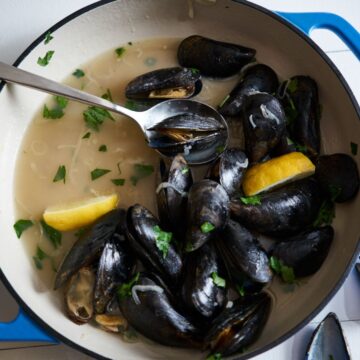




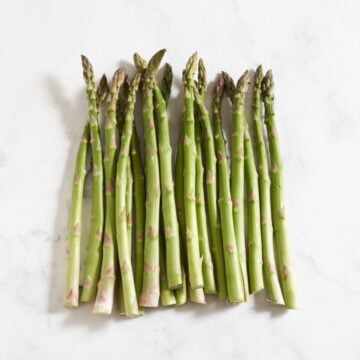
Leave a Reply